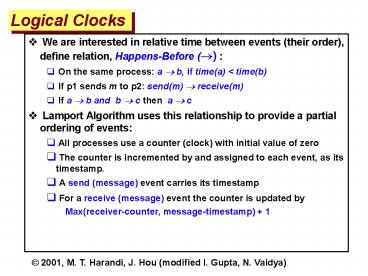Logical Clocks PowerPoint PPT Presentation
Title: Logical Clocks
1
Logical Clocks
- We are interested in relative time between
events (their order), define relation,
Happens-Before (?) - On the same process a ? b, if time(a) lt time(b)
- If p1 sends m to p2 send(m) ? receive(m)
- If a ? b and b ? c then a ? c
- Lamport Algorithm uses this relationship to
provide a partial ordering of events - All processes use a counter (clock) with initial
value of zero - The counter is incremented by and assigned to
each event, as its timestamp. - A send (message) event carries its timestamp
- For a receive (message) event the counter is
updated by Max(receiver-counter,
message-timestamp) 1
2
Events Occurring at Three Processes
3
Lamport Timestamps
4
Example Lamport Logical Time
Physical Time
1
2
Host 1
4
0
3
1
4
3
Host 2
0
2
2
3
3
Host 3
4
0
7
3
5
6
4
6
Host 4
0
5
6
8
Clock Value
n
timestamp
Message
5
Example Concurrent Events
Physical Time
1
2
Host 1
4
0
3
1
4
3
Host 2
0
2
2
3
3
Host 3
4
0
7
3
5
6
4
6
Host 4
0
5
6
8
Clock Value
n
timestamp
Message
6
Vector Logical Clocks
- With Lamport Logical Time
- e precedes f ? timestamp(e) lt timestamp (f),
but - timestamp(e) lt timestamp (f) ? e precedes f
- Vector Logical time guarantees this
- All hosts use a vector of counters (logical
clocks), ith element is the clock value for host
i, initially all zero. - Each host i, increments the ith element of its
vector - upon an event, and assigns the vector to the
event. - A send(message) event carries its vector
timestamp (counter vector) - For a receive(message) event,
- Max(Vreceiverj , Vmessagj), if j
is not self - Vreceiverj 1 otherwise
X
Vreceiverj
7
Vector Timestamps
8
Example Vector Logical Time
Physical Time
Host 1
0,0,0,0
Host 2
0,0,0,0
Host 3
0,0,0,0
Host 4
0,0,0,0
Vector logical clock
n,m,p,q
(vector timestamp)
Message
9
Comparing Vector Timestamps
- VT1 VT2,
- iff VT1i VT2i, i 1, , n
- VT1 lt VT2,
- iff VT1i lt VT2i, i 1, , n
- VT1 lt VT2,
- iff VT1 lt VT2
- ? j (1 lt j lt n VT1j lt VT2 j)
- VT1 is concurrent with VT2
- iff not (VT1 lt VT2 OR VT2 lt VT1)
10
Summary
- Time synchronization for distributed systems
- Cristians algorithm
- Berkeley algorithm
- NTP
- Relative order of events
- Lamports logical clocks
- Vector clocks
- Next topic Global Snapshots.
PowerShow.com is a leading presentation sharing website. It has millions of presentations already uploaded and available with 1,000s more being uploaded by its users every day. Whatever your area of interest, here you’ll be able to find and view presentations you’ll love and possibly download. And, best of all, it is completely free and easy to use.
You might even have a presentation you’d like to share with others. If so, just upload it to PowerShow.com. We’ll convert it to an HTML5 slideshow that includes all the media types you’ve already added: audio, video, music, pictures, animations and transition effects. Then you can share it with your target audience as well as PowerShow.com’s millions of monthly visitors. And, again, it’s all free.
About the Developers
PowerShow.com is brought to you by CrystalGraphics, the award-winning developer and market-leading publisher of rich-media enhancement products for presentations. Our product offerings include millions of PowerPoint templates, diagrams, animated 3D characters and more.

